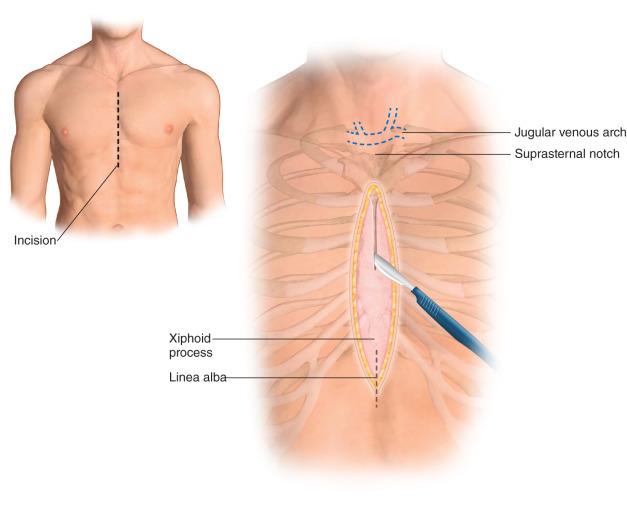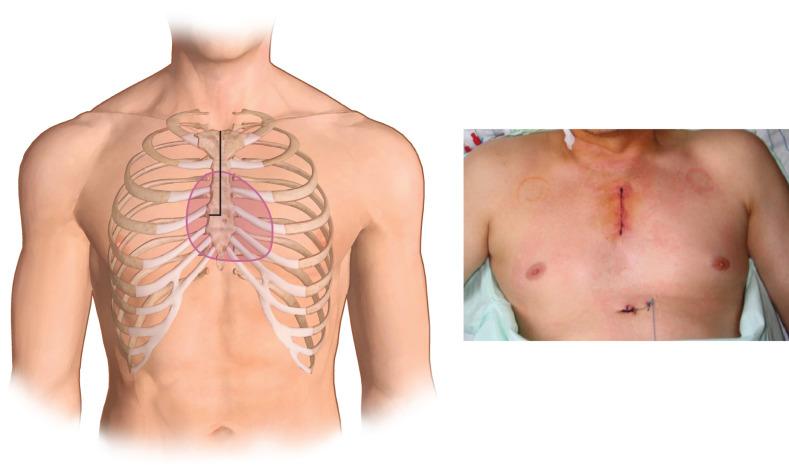Physical Address
304 North Cardinal St.
Dorchester Center, MA 02124
The median sternotomy was reintroduced by Julian in 1957, which was already described by Milton in 1897. The median sternotomy has become a gold standard approach for cardiac procedures, with subsequent developments in cardiac surgery. The skin incision could be shortened caudally or cranially up to half the length of the sternum. This approach allows excellent access to every cardiac chamber and to vessels entering and leaving the medial mediastinum. It could also be extended laterally through the ribs into the intercostal space, which allows extension of the procedure to the distal arch and descending aorta, if required.
Another approach is the thoracotomy. Ludwig Rehn, in Frankfurt, Germany, is noted as the first surgeon who successfully placed a suture through a left-sided thoracotomy. This was done in 1896 on the heart of a 22-year-old gardener's assistant, who was injured after a stabbing.
A thoracotomy can be divided into anterior and posterior thoracotomies, depending on the surgical procedure required. The anterior approach allows good access to the internal mammary artery and to the coronary vessels and heart valves. The posterior thoracotomy requires a lateral decubitus position and enables access to the descending aorta and distal aortic arch. During thoracoabdominal aortic surgery, this incision could be extended and combined with a pararectal incision and entry into the retroperitoneum.
The choice of incision is influenced by certain factors, such as urgency of the procedure, nature and extent of the procedure, and possibility or necessity of extension of the procedure. A history of previous cardiac or thoracic procedures, comorbidities of the patient, patient's preference, and cosmetic aspects are other factors.
Diabetes, obesity, chronic obstructive pulmonary disease, and the use of bilateral mammary arteries are known risk factors of a sternal wound infection. These factors may influence the decision of which incision to use and the method of closure.
The most essential consideration in performing a sternotomy is that it is done through the midline. The suprasternal notch and xyphoid process are used as landmarks. The latter sometimes has an asymmetric configuration and therefore it is helpful to control the edge of the ribs on both sides to find the middle. A paramedian sternotomy may be harmful to the sternum and is a significant risk factor for sternum instability, which could lead to disturbances in wound healing.
The patient is placed supine on the operating table. A linear incision is made from just above the sternal angle to the level of the xiphoid process. Subcutaneous fat and presternal fascia are divided, and the linea alba is divided inferiorly about 2 to 3 cm to obtain adequate exposure of the pericardium ( Fig. 1.1 ). It is essential to divide the interclavicular ligament at the top of the suprasternal notch using electrocautery. Special attention should be taken to identify the veins crossing this area—the jugular venous arch. Injury of the veins in this area could injure other important structures, such as the trachea or brachiocephalic artery, if the bleeding is not controlled, especially if the view is limited due to small incisions. There are also veins crossing the upper part of the xyphoid cartilage, which should be identified and cauterized. The midline of the sternum is marked by electrocautery. Scissors could be used to divide the xyphoid process separately. The sternum is divided with a saw in a caudocranial fashion, with close attention paid to staying on the midline. The sternum could be also be divided in a craniocaudal fashion, changing the direction of the saw blade.

It is prudent to ask the anesthesiologist to stop the mechanical ventilation to avoid unnecessary opening of the pleura with the saw. The saw should be lifted slightly against the posterior plate of the sternum, and care should be taken to avoid injury to the pericardium, thymus, and innominate vein. If the peritoneum is opened accidentally, it is important to close the peritoneum expeditiously to avoid fluid incorporation and subsequent adhesion in the peritoneum. Extension of the incision cranially facilitates exposure of the arch and supraaortic vessels. On the other hand, the gastroepiploic artery could be harvested, extending the incision into the peritoneal space.
In patients with previous cardiac procedures, extra attention must be paid not to injure the cardiac structures, which could lead to hemorrhagic shock or an air embolism, with lethal consequences. Careful blunt dissection may be performed below the xyphoid process to free the pericardial and pleural adhesions. Gentle elevation of the sternum with sharp hooks or unloading and establishing a cardiopulmonary bypass (CPB) over the femoral vessels may be advisable in select cases as a safeguard. In case of redo, computed tomography (CT) and magnetic resonance imaging (MRI) are helpful imaging modalities to evaluate the risk of reentry.
After sternum division, hemostasis is obtained by cauterizing the periosteal surface of the sternum. Bone wax may be used to seal the bone marrow and control bleeding, although some surgeons prefer to simply apply a towel.
In redo cases, it is crucial to dissect the attachment to the edge of the sternum before retracting because the retraction could injure structures, such as the lung or innominate vein through tension.
An upper or lower partial sternotomy may be used for certain procedures, such as isolated aortic or mitral valve repair or replacement or bypass surgery with certain target vessels. The sternum could be divided into different patterns through the third or fourth intercostal space—J shape, L shape, or inverted T shape ( Fig. 1.2 ). The fourth intercostal space usually enables a good exposure of the aorta and root to be obtained. Access to the right atrium could be limited, which makes direct insertion of the venous cannula into the appendage of the right atrium laborious. It is important to have the option to cannulate the femoral vein if exposure of the right atrium is not sufficient, especially in the case of a smaller incision through the third intercostal space. Venting through the pulmonary artery may be useful in select cases with limited access to the upper right pulmonary vein.

A small incision has the advantage of reducing the wound area and preventing wound infections due to sternum instability, reducing the requirement for a blood transfusion, and shortening the stay in the intensive care unit. Small incisions are also preferred by the patients for cosmetic reasons.
Become a Clinical Tree membership for Full access and enjoy Unlimited articles
If you are a member. Log in here